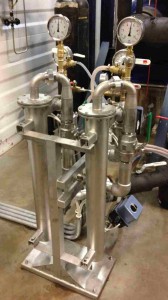Hydrocyclone
The strong spiral flow in a hydrocyclone separates and classifies particles and fluids of different specific gravity. Optimized conical shape and the location of inlet and overflow ports create a flow path for the fluid with concentric spiral flows downwards and upwards inside the hydrocyclone. The main flow rises in the center of the cyclone and exits through the port located centrally in the top cap of the cyclone. Impurities and particles exit at the tip of the cyclone as the reject or apex flow. The tip is exchangeable and the tip opening adjustable for optimal apex flow. The reject is typically 2…5 % of the flow through the cyclone. The hydrocyclone works as an effective dynamic filter for many different applications. Hydrocyclones require only a minimum of maintenance and do not normally need backflushing or manual cleaning.
Filtercyclone
The filtercyclone is a filtering device for precise and economical filtration of fluid flows without the use of filtration beds or filter cartridges requiring replacement.
In a filtercyclone the dynamic separation capacity of the hydrocyclone is combined with the precision filtration of a filtering element at the center. The device utilizes the spiral flow of the fluid for course separation and continuous flushing of the filter surface. The filtercyclone can be used continuously with a reject flow for filtered sludge, or intermittently with backflush intervals. The filter element is very durable and consists of a sintered titanium matrix, shaped to run the height of the cyclone shell. The filtercyclone is available in different filtering grades 2 μm…40 μm. The technology has several applications in water and sewage, heating and cooling processes and general process industry.
Mixing and Oxidation
The laminar flow in a hydrocyclone has classification capacity and is also suitable for mixing purposes. A homogenous fluid flowing through a cyclone will arrange itself in layers in a laminar fashion, where the layers have different flow velocities. Soluble substances or materials with different specific gravities added to the flow will be subjected to strong shear forces and variations in pressure between the flow layers. Dissolution and mechanical mixing are efficient and fast.
Also the adding of gases, such as air into a fluid, is possible thanks to the efficient mixing action in the laminar flow. Air can be sucked with an eductor from the atmosphere or as aided by compression, and lead into a dispersion unit, consisting of one or several closed hydrocyclones connected in series. The air mixed into the water is broken into micro bubbles, which will enhance the efficiency of the dispersion fluid. The process can be combined with the mixing of chemicals.
Recycling of Water
Recycling and recovering of process and wash water is an efficient way to save costs and limited resources, and the environment. A working recycling system for water consists of several treatment phases, such as settling, hydrocyclone particle separation, oxidation and separation by flotation, and controlled biological decomposition. The various phases are selected according to requirements of the individual process. A well-designed recycling system does not need added chemicals or nutrients, or replaceable filter elements. High recovery rates are possible in water recycling systems, and plant investments are frequently very profitable.




